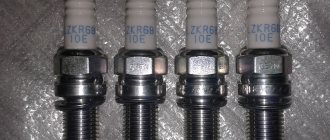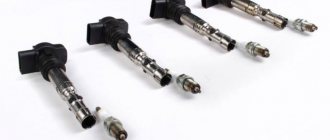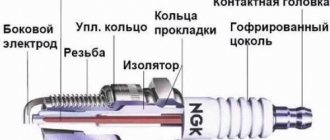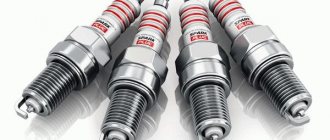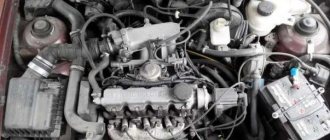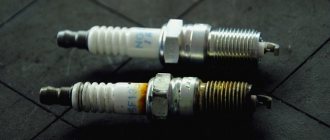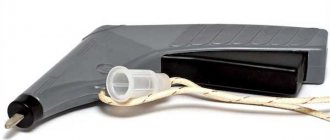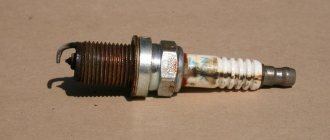The process of replacing spark plugs, both ignition and glow plugs, is largely similar. This is due to the method of their installation and location (in the engine cylinders). In this article we will consider the question of how to change spark plugs yourself, what tools are needed for this, at what mileage to change them, at what torque to tighten them and other important notes.
A spark plug is an important element of electrical equipment, whose task is to convert electrical energy into a spark discharge, which in turn ignites the fuel-air mixture located in the cylinders. For the most efficient combustion process in the cylinders of this mixture, the required spark discharge must be continuously created by the spark plug. Also, the candle should not be a source of glow ignition and should have the ability to self-clean from carbon deposits.
Glow plugs are designed to make diesel engines easier to start in cold weather. In essence, they are electric heating elements. Their work is based on an electric spiral made of metal with high ohmic resistance. When a diesel engine operates in cold weather, the spark plug coils heat the air and cold metal of the engine, as well as the fuel, to a high temperature. As a rule, their operating time is 2...5 seconds after turning on the ignition.
Spark plugs and glow plugs fail sooner or later. This can be caused by various reasons - natural aging, use of low-quality fuel and mechanical damage. Let's take a closer look at the signs and reasons for their failure.
Symptoms of a problem
Let's start with spark plugs, as they are more common. So, signs of their malfunction include:
- difficulties when starting the engine (usually this is accompanied by prolonged operation of the starter);
- the engine “troits” (the car jerks when moving, picks up speed poorly, it lacks traction and power);
- significant increase in fuel consumption;
- increase in the amount of CO in exhaust gases;
- decreased engine dynamics (insufficient speed).
Spark plug device: 1 - thread; 2 — end of the body (rim): 3 — side electrode: 4 — central electrode; 5 — thermal cone of insulator (“skirt”)
It is worth mentioning here that the listed signs may indicate other engine malfunctions. However, if at least one of them appears, it is necessary to check the condition of the spark plugs, especially since this is not difficult to do.
Now let's move on to the glow plugs. Signs of their failure are:
- Difficulty starting the engine in cold weather. In particularly difficult cases, it is impossible to start the car at all.
- The engine runs rough at idle speed .
- White smoke comes out of the exhaust pipe (simulating a rich fuel-air mixture);
- Inoperative spiral indicator on the dashboard. If it does not light up, then there is a high probability that the temperature sensor or fuse has failed, but sometimes it can also indicate a failure of the spark plugs. But when this light bulb glows constantly. In this case, the thermal switch will most likely need to be replaced. If this is not done in time, the glow plug may fail completely.
Now let's move on directly to the reasons why the spark plugs failed.
Causes of malfunctions
Let's start again with the spark plugs. The reason for their partial or complete failure may be:
Worn and new spark plugs
- natural wear and tear;
- the presence of a large amount of soot;
- presence of oil on the electrodes;
- varnish deposits;
- slag deposits;
- failure of the central electrode;
- candle melting;
- spark plug connector wear.
As for glow plugs, the causes of their malfunctions may be:
- natural wear and tear;
- low quality diesel fuel (presence of moisture or various impurities);
- problems with electrical wiring;
- problems with the electronic control unit.
As a rule, one spark plug fails. If two spark plugs are faulty at once, the engine simply will not start. But if all the existing ones fail, then the reason must be sought, most likely, in the ECU.
Now let's move directly to the main question, how to change spark plugs or glow plugs. In many ways, these two procedures are similar. So, according to tradition, let's start with the spark plugs.
How to replace a spark plug
Despite the variety of models and engines, in most cases the replacement algorithm will be the same (perhaps with the exception of small nuances associated with the design features of a particular motor).
Remember that replacement must be done with the engine turned off. Moreover, you need to give the engine and spark plugs some time to cool, otherwise you risk getting burned.
To work you will need the following tools:
Candle key
- ratchet wrench with ratchet mechanism (spark wrench);
- extension cord for the key (in some cases it is needed if access to the cylinder head is easy);
- spark plug head (usually included with a key);
- a tool for measuring the spark gap between the electrodes (this can be a special meter or a corresponding set of probes);
- new candles (we will not consider their choice in this article);
- a set of standard locksmith tools (keys, screwdrivers) for dismantling the protective casing on the engine;
- metal wire brush or compressor;
- dielectric grease;
- dielectric silicone compound.
So, the step-by-step replacement algorithm will be as follows:
- Remove the engine guard and other components if they restrict access to the spark plugs.
- Using a compressor or brush, remove dirt around the spark plug so that it does not get into the spark plug well in the future (you can simply blow the dust thoroughly with your mouth).
- Grab the wire cap with your hand as close to the engine as possible and gently pull it towards you in order to remove the terminal from the spark plug. Do not pull to avoid damaging the cap or wire .
- Take a prepared socket wrench with an extension and a spark plug head, and use it to unscrew the old spark plug from its seat. It is better to unscrew and change the spark plugs one at a time . Otherwise, mark the wire connection sequence.
- Check the condition of the spark plug well threads (by shining a flashlight if possible). If necessary, clean it and use dielectric grease (discussed later). It is advisable to apply a dielectric silicone compound to the connection terminal so that in the future it will be easier to disconnect it from the spark plug.
- Also check the wires and terminals. To clean them, you can use a wire brush, rags, or a compressed air compressor. If the insulation or terminals of the wires have significant wear, it is better to replace them. The insulation resistance value can be checked with an ohmmeter (multimeter); its value should not be less than 0.5 MOhm.
- Screw a new candle into the well. In this case, it is advisable to use a dynamometer indicating torque (we will talk about torque values below). If you don’t have a dynamometer, then select the “feels” value. The candle does not need to be “twisted”, as this can damage the threads and disrupt heat transfer.
- Connect the terminal to the spark plug.
- Install the previously removed protective elements, including the protective casing.
If the old plug did not completely burn fuel, then some of it probably accumulated under it. Accordingly, when you install a new candle, it will take some time for it to burn this residue. In this case, most likely, the engine speed will be slightly higher than usual. Don't worry, everything will be back to normal within a couple of minutes after starting.
We recommend: How to check the oil pressure in the engine and what it should be?
Try not to drop anything into the spark plug wells. If dust or debris gets there, you can use a compressor to remove it. You can also start the engine without a spark plug, and the piston itself will push out the fuel mixture mixed with debris.
How to change glow plugs
Now let's move on to step-by-step instructions on how to change glow plugs. To do this you will need the following tools:
- a tubular wrench for unscrewing spark plugs (usually included in the standard set of tools when purchasing a car) with an extension;
- new glow plugs;
- dielectric grease and dielectric silicone compound;
- a set of locksmith tools (keys, screwdrivers) for dismantling the protective casing on the engine;
- metal wire brush or compressor;
- reamer of appropriate length and with suitable thread.
Remember that replacing glow plugs must be done when the engine is cool. Otherwise, you may get burned. Although in some cases, when the candle has become very stuck, it is recommended not to turn it while it is hot, but only to get it out of its place.
The replacement algorithm will look like this:
- It is necessary to remove the plastic protective casing from the engine (if present), as well as elements that may impede normal access to the spark plugs.
- Next, remove the upper cylinder head casing (after unscrewing the fasteners). It is also recommended to remove the oil dipstick for ease of operation.
- The contact wires are removed from the spark plug. This operation must be carried out carefully; you must pull the cap right next to the spark plug body, otherwise you risk damaging the wire or contact terminals.
- Using a spark plug wrench, carefully turn the spark plug out of its seat. It is better to replace one spark plug at a time so as not to mix up the contact wires. Otherwise, the latter need to be marked. Screws for the spark plug well
- Inspect the seat (thread). To do this, use a reamer (a bolt or blank with a thread that fits the seat). This will remove dirt and carbon deposits from the grooves. Apply dielectric compound to the threads. Inspect the terminal in the same way. Clean it with a brush or compressor. After this, apply dielectric silicone compound.
- Install a new spark plug into the seat and tighten it using a wrench. It is advisable to use a torque wrench for this (we will talk about the points below). If it is not there, then try not to twist the thread.
- Connect the wire to the spark plug.
- Reinstall the upper cylinder head cover as well as the protective cover.
In some cases, there is no need to install new glow plugs; instead, it is enough to check and diagnose the old ones. You can read how to do this in the additional material. After the inspection, the candle can still serve for a long time.
Everything is fine if:
- Thread 1 is completely dry, not wet;
- Rim 2 - has a dark color and a thin layer of soot or soot;
- The color of the electrodes 3, 4 and insulator 5 can be from whitish, light gray, light yellow to light brown.
You can find out about the malfunction by:
- Wet thread, it can be in gasoline or oil.
- The rim is covered with black, spotted, loose soot.
- The electrodes and insulator, if their color is dark brown with spots, sometimes a yellow spot appears on the very bend of the side electrode.
If the spark plug is not installed hermetically, then dark rims appear on the outside of the metal body and on the insulator. In this case, the spark plug does not work; the rim, insulator cone and electrodes become covered with soot and become wet. Soot deposits can be cleaned with a brush with metal bristles; in cases where mechanical damage and melting are noticeable, the spark plug should be replaced.
Special attention should be paid to the color of the spark plug soot; it can tell a lot about the condition of the engine.
General acquaintance
Let's look at the types of spark plugs.
The simplest SZ is considered to be a product with two electrodes, made of heat-resistant material. Devices that have multiple electrodes are called multiple SZ. They are durable; if one electrode burns out, a spark appears on the second contact. The presence of spare electrodes increases the service life of the product. Devices with platinum-coated contacts are called platinum SZ; they help reduce the resistance to the electrical part of the machine. Products with iridium tips help reduce fuel mixture consumption and have an increased service life.
Candle life
Daewoo Nexia Capricious girl Logbook Unloaded the Nexia ignition switch
The service life of spark plugs depends on many factors. Manufacturers determine the period of operation of these elements depending on the materials from which the electrodes are made, approximate operating conditions (climatic conditions, fuel quality, etc.). So, for classic spark plugs, the average service life is no more than 50 thousand kilometers. For platinum and iridium - no more than 90 thousand kilometers. Naturally, these figures can be adjusted depending, for example, on the quality of gasoline that is poured into the car and the condition of the engine itself. Therefore, many car manufacturers recommend replacing classic spark plugs during every second scheduled maintenance (for example, after 30 and then 60 thousand kilometers). When using platinum or iridium spark plugs, the service life can be increased by one and a half to two times.
What types of candles are there?
MICsher Blog Finding characteristic sores of Daewoo Nexia N150
In everyday life, spark plugs are called classic, platinum and iridium.
They received such names because of the materials used to make electrodes. In classic spark plugs, the electrodes are made of copper, in platinum spark plugs they are made of platinum, and in iridium spark plugs they are made of a special iridium alloy. In some classic spark plugs, copper electrodes are coated with yttrium alloy for reliability, which increases the stability of the spark plug electrodes. Platinum spark plugs are good because platinum has high corrosion resistance and resistance to high temperatures (they practically do not burn out), which allows them to achieve a fairly long service life. Iridium spark plugs have characteristics similar to platinum spark plugs. But the most durable spark plugs are those in which the electrodes are made of an alloy of platinum and iridium.
Diagnostics looking for a spark plug with a defect
Selection of Ngk spark plugs by car
Problems can be identified visually even with the naked eye. However, damage is obvious when the car runs unevenly and stalls. It is worth remembering that malfunctions of this kind make it impossible to ignite the fuel-air spark plug in the cylinder.
As a result of the fact that fuel does not burn, it can get into the catalyst. There will be a strong smell of gasoline. Another clear sign of a faulty spark plug is a significant increase in fuel consumption. This happens because the mixture does not burn completely due to
For efficient combustion in gasoline engines, the temperature in the cylinders must reach 400-500 degrees or more. This is possible by compressing the fuel mixture, which further increases the temperature. This is the only way the mixture will easily, and most importantly, completely, ignite and burn.
However, high temperatures do not have the best effect on the service life of candles. Most often, layers are found on old parts. You can also see deposits on the electrodes, which affect the quality of the spark. It should be remembered that on a working spark plug, the electrode has a uniform color and uniform shape, and there are no deposits.
Appearance of SZ
Spark plugs that require replacement.
Signs of faulty spark plugs can be determined by the appearance of the products:
- Presence of mechanical damage on the spark plug body, change in the shape of the electrodes or sealing washers. If these symptoms are detected, the SZ must be replaced. Cause of malfunction:
- the glow number of the spark plugs does not correspond to the type of engine;
- cooling system problems;
- increased ignition timing.
- The presence of black carbon deposits indicates an over-enriched fuel mixture, which burns partially, resulting in a lot of soot, and the ignition spark has insufficient strength.
- The candle takes on a glossy glassy appearance. This symptom indicates overheating of the product, which occurs when using a lean fuel mixture or the car was driven on a gas-air mixture.
- The formation of oil deposits indicates the presence of motor fluid in the combustion chamber. Cause of failure: leakage of lubricant through the oil seals of the cylinder head valves, or wear of the piston group.
- Deposits of a yellow-brown hue, which are formed due to carbon deposits on the dielectric of the spark plug nose.
- A chip or break in the spark plug insulator indicates sudden overheating or cooling.
- Erosion of the spark plug contact occurs due to the presence of corrosion and oxidative reactions with lead. The cause of the malfunction lies in an increase in the spark plug gap.
- Contact melting is the result of overheating.
- Red soot indicates an excess of metal-containing additives in the fuel.
We recommend: Fixing the problem with low beam lamps on the Lada Kalina
If the power unit is operating normally, then the spark plug carbon deposits should be light gray-brown in color.
We recommend watching a video about the need to change the SZ:
Possible reasons for the appearance of soot
Before answering the question of why the candles are black, you need to decide how exactly they turned black
. After all, it depends on which direction to search. In particular, the candles can turn black all together, or maybe only one or two of the set. Also, the candle may turn black only on one side, or perhaps along its entire diameter. There are also so-called “wet” and “dry” carbon deposits.
It should be noted that the speed of appearance and nature of carbon deposits directly depends on existing faults (if any):
- Carbon deposits on new spark plugs begin to form after at least 200-300 km. Moreover, it is advisable to drive along the highway at approximately the same speed and engine load. This way the spark plugs will work in optimal mode, and it will be possible to more objectively assess the condition of the car’s components.
- The amount and type of soot depends on the quality of the fuel used. Therefore, try to refuel at trusted gas stations, and not drive with gasoline or similar mixtures. Otherwise, it will be difficult to establish the real cause of the appearance of soot (if it occurs).
- In a carburetor engine, the idle speed must be set correctly.
Now let's move directly to the question of why black soot appears on the spark plugs. There may be 11 main reasons
:
As a rule, when the ignition is set late and the air-fuel mixture is rich, the following consequences arise:
- misfires (appears on injection engines);
- problems starting the engine;
- unstable engine operation, especially at idle, and as a result, increased vibration levels.
The importance of quality spark plugs
The resulting spark in the combustion chamber “ignites” the fuel-air mixture, starting a workflow that allows the engine to function fully. Thanks to spark plugs, the power unit comes to life, without them remaining a useless piece of metal.
The slightest defect in the spark plugs can have a detrimental effect on the performance of the engine, even to the point of failure. Therefore, if you suspect even minimal problems with the spark plugs, it is necessary to eliminate them without waiting for fatal consequences.
When a part fails, the load on the ignition coil increases, quickly ending in its failure. At the same time, the price of a spark plug is disproportionately small compared to the price tag for a coil. Driving with an engine with faulty spark plugs is characterized by instability at idle and increased driver nervousness.
A well-tuned power unit operates smoothly and softly at 1000 rpm. Faulty spark plugs cause jumps in the tachometer readings, and at the same time the engine may vibrate or make an unpleasant grinding noise. Therefore, even a person who is far from car hardware can determine the cause of unstable engine operation, due to the ignition system.
Symptoms of malfunctions
Additional factors influencing the condition of the spark plug, as well as its operating temperature:
- fuel quality;
- increased compression;
- change in ignition timing;
- temperature conditions of the region in which the vehicle is operated;
- humidity.
The following symptoms in vehicle operation may indicate a faulty spark plug:
- Poor engine starting when cold. Moisture concentration forms on unheated spark plugs in the cylinders when starting the power unit. If the interelectrode gap is large, there is a need to increase the breakdown voltage; electricity tends to lower resistance, that is, to moistened electrodes. Also affected by a decrease in battery capacity in the cold, as a result, a very small amount of energy is required for the formation of a spark, and the engine does not start.
- Increased consumption of the fuel mixture by the machine. Insufficient ignition in the cylinders leads to a decrease in power; to compensate for it, an excess amount of fuel enters the remaining cylinders (in which the spark plugs are working).
- Extraneous noises emitted while the power unit is warming up or at idle speed.
- Increase in harmful emissions from the exhaust pipe.
- Filled with SZ fuel.
- Reduced traction of the car, the vehicle does not gain enough speed.
Unpleasant consequences of untimely replacement of SZ:
- Reduced catalyst life. Insufficient ignition of the fuel mixture in the cylinders leads to the ingress of unburnt fuel residues into the catalyst. Once in the catalyst, the fuel burns out, and the layer on the catalyst honeycomb burns out. Damage can also be caused to the lambda probe.
- Broken ignition coil. An increased breakdown voltage contributes to an increase in the distance between the spark plug electrodes - this leads to a breakdown of the insulation of the coil layers, and it fails.
- Reducing the operating period of the motor. The entry of the fuel mixture into a faulty cylinder leads to fuel entering the crankcase, which reduces the oil life and wears out the cylinder.
When driving with faulty spark plugs, explosive popping noises can occur inside the combustion chamber. This is fraught with replacement: the crankshaft, piston group, connecting rod.
How to check spark plugs
Signs of contamination or failure of spark plugs appear in the form of interruptions in engine operation; an engine with dirty or problematic spark plugs will suffer. This happens because all the candles usually do not fail at once. Interruptions begin in only one or two cylinders. The first step is to identify the spark plug that has failed. There are several ways to check spark plugs:
- using a device or tester to check spark plugs;
- independent checking of spark plugs;
To check the spark plugs, you need to remove them, although there are also ways to diagnose spark plugs on a car. Before starting the procedure that involves removal, you should turn off the ignition and prepare a special spark plug or socket wrench. You will need a tool to unscrew the spark plugs. Then you need to inspect the high-voltage armored ignition wires. These wires usually have special markings that contain information about the cylinder number. If there is no such marking, you will need to mark the high-voltage spark plug wires yourself in an accessible way.
The next step is to remove the tips (caps) from the spark plugs
Please note that you should not pull on the high-voltage wire while performing this procedure, as this may damage the armor wire. To remove, you need to hold onto the tip itself.
After removing the spark plug caps, you can unscrew the spark plugs using a wrench. V-twin engines will require a long drive wrench, similar to a torque wrench. An extended collar will also work.
During removal, you should remember which cylinder each unscrewed spark plug corresponds to, since further inspection will allow you to determine possible malfunctions not only of the spark plugs, but also of the engine based on the condition of the spark plugs. Checking the spark plugs should begin with a visual inspection and checking the condition of the insulator, as well as the electrodes. Cracks or melting, as well as other noticeable defects, are not allowed. Next, the candles are installed on a special stand or checked with a device. As mentioned above, motorists also check the spark plug directly on the car or use a multimeter. We will talk about various verification methods below.
There is a spark, the starter turns normally, but the spark plugs are flooded
Quite often you can encounter a situation where there is a spark, the spark plugs are flooded, and the starter spins the crankshaft well. In such a case, the spark plugs may require a separate check, since the presence of a spark on them does not mean that the same spark will always be created under pressure. In other words, if there was a spark on the unscrewed spark plug, then after installation on the engine it may disappear. The reason is increased pressure in the combustion chamber, which is created during the operation of the internal combustion engine. To find out, you need to carry out diagnostics on a special stand for checking spark plugs, which simulates the operation of these elements taking into account high pressure (similar to the operation of spark plugs in the combustion chamber).
At the same time, the injectors themselves and ECM sensors may need diagnostics. For example, in the event of a malfunction, the coolant temperature sensor may send incorrect data to the computer. In this case, the control unit enriches the mixture and the injectors overflow fuel. In rare cases, the electronic engine control unit itself fails.
Tip 4 How to make candles
In order to make candles, you will need quite a lot of different materials and just as much patience, but if you finish the job, you will want to repeat it all.
So, you will need a wick. Depending on the type of candle you'll be using, you can choose a braided wick, which is most often used for square-shaped candles, or a wrapped wick, but this wick is best used for candles that will be poured into a container.
Next you need a wick holder. A piece of wire or a special metal holder can be used as a holder.
Next comes the sealant. In fact, the sealant in this case is sticky wax, with the help of which you close the hole that is formed after you drag the wick through the base of your future candle.
Next in making a candle is wax. The choice of wax is limited to two options; you can either use beeswax or paraffin. Only here you should remember that paraffin does not emit a smell when burning, and also remember that it burns much faster than wax.
Next, you need a container in which you will melt the wax. It is best to purchase a special container for this purpose, but you can also use an old Turk for these purposes, the result will be the same. Just make sure that there are no seams in your dishes.
Stand. This is a very important element that will come in handy while you are making a candle. Because remember that you are dealing with hot ingredients, so a trivet will come in handy here.
You will also need a special thermometer; if you don’t have one, it’s better to buy one; a regular thermometer will not work here. If you work without a thermometer, you risk boiling the wax, which can have undesirable consequences.
And, of course, you will need molds, because in order to make candles, molds are a must. There is a fairly large selection of these forms, but you can use the forms for freezing juice and making muffins.
And, of course, when making a candle you cannot do without a variety of decorative details, because it is thanks to them that your candle will become that unique creation that you spent so much time making.
Los4inin Blog Diagnostics of internal combustion engines based on the condition of spark plugs
Spark plugs, these simple-looking metal and ceramic connections, are a critical element in engine performance. Even by the appearance of the spark plug, you can tell a lot about both the operation of the engine as a whole and its individual components.
Inspection of the spark plug should be carried out after prolonged operation of the engine; the ideal option would be to inspect the spark plug after a long trip on a country highway. The mistake of some car enthusiasts, for example, is that after a cold start of the engine at sub-zero temperatures and its unstable operation, the first thing they do is unscrew the spark plugs and when they see black carbon deposits, they draw hasty conclusions. But this carbon deposit could form during engine operation in cold start mode, when the mixture is forcibly enriched, and unstable operation could be a consequence of, say, the poor condition of high-voltage wires.
Photo No. 2 shows a typical example of a spark plug from an engine with high fuel consumption. The central electrode is covered with velvety black soot. There are several reasons for this: a rich air-fuel mixture (incorrect carburetor adjustment or injector malfunction), clogged air filter.
Running an engine on leaded gasoline results in the formation of conductive, yellowish-brown deposits, which also reduce the likelihood of a spark forming at the spark plug. At room temperature, the presence of conductive deposits is not detected by instruments (ohmmeter).
The spark plug in photo No. 6 was removed from a non-functioning cylinder. The central electrode and its skirt are covered with a dense layer of oil mixed with drops of unburnt fuel and small particles from the destruction that occurred in this cylinder. The reason for this is the destruction of one of the valves or the breakage of the partitions between the piston rings with metal particles getting between the valve and its seat. In this case, the engine “troubles” incessantly, a significant loss of power is noticeable, fuel consumption increases by one and a half, two times. There is only one way out - repair.
Photo No. 8 The spark plug electrode is overgrown with ash deposits, the color does not play a decisive role, it only indicates the operation of the fuel system. The reason for this build-up is oil combustion due to depletion or obstruction of the oil scraper piston rings and the unsatisfactory condition of the oil seals. The engine has increased oil consumption, when over-gasping, there is strong blue smoke from the exhaust pipe, and the exhaust smell is similar to that of a motorcycle.
Photo No. 9 Destruction of a ceramic insulator. Causes of occurrence: a sharp change in temperature, for example when a spark plug removed from a hot engine is cooled in cold water. In some cases, destruction may be caused by a defect in the candle itself (defective or counterfeit), or by mechanical damage, for example as a result of a fall.
Signs of electrode erosion: the engine performs poorly, runs unstably even after warming up, misfires, and does not develop the required power.
Photo No. 11 Spraying a candle with gasoline. Often occurs due to a malfunction of the ignition system or carburetor / injector (flow). In winter, this can occur due to the fact that gasoline entering the combustion chamber does not have time to evaporate and settles on the spark plugs and cylinder walls. The solution is to unscrew the spark plugs and wash them with alcohol and let them dry or blow them with air. If you want to have fewer problems with the operation of your engine, do not think about the spark plugs only when the engine refuses to work. The manufacturer guarantees trouble-free operation of the spark plug on a working engine for 30 thousand kilometers. But you, in turn, do not forget to check the condition of the spark plugs with every oil change or on average every 10 thousand kilometers. First of all, this is adjusting the gap to the required value and removing carbon deposits. It is better to remove carbon deposits with a metal brush; sandblasting destroys the ceramics of the central electrode, and you risk getting a copy of photo No. 7.
It is recommended to periodically change spark plugs, this is due to different temperature conditions of the cylinders.
How to diagnose engine problems using spark plugs?
Yes, spark plugs are the most valuable among the simplest methods for diagnosing various kinds of engine problems. You can actually "read" your spark plugs and get valuable clues about how your car's engine is performing, what it's missing most, and where trouble is coming from.
Of course, to read a spark plug and evaluate engine problems, you must first remove it. Use a spark plug wrench for this.
You can read more about how to remove a spark plug in the article on replacing spark plugs. First, let's take a look at what main parts a spark plug consists of:
As you can see, everything is extremely simple and obvious. Now let's take a look at what spark plug conditions mean, how to correctly diagnose engine malfunctions and problems based on such conditions, as well as options for solving problems.
Select from the images below what your spark plug looks like:
Normal candle
A coating of coffee, brown or gray-brown color on the white skirt (if the car runs on gas, the color will most likely be brown), and small traces of erosion on the electrodes.
The engine is running normally.
Worn spark plug
This is a normal process for the spark plug to wear out and require replacement. Remember that spark plugs need to be changed regularly because as they wear, the gap between the spark plug electrodes increases, which requires more voltage to produce a spark.
The normal growth rate of the gap for most spark plugs is considered to be as follows: for four-stroke engines: 0.01
Ash deposits
The central and side electrodes are covered with an ashy coating. As a result of this “masking” of the electrodes, your engine may experience misfires. In advanced cases, this accumulation of combustion deposits may eventually (but usually does not) fill the entire gap between the two electrodes.
Causes:
- Poor fuel quality (presence of harmful additives).
- Oil enters the combustion chamber due to leaking piston rings or other reasons.
What to do:
- Replace spark plugs.
- Change your usual gas station.
- Check engine compression to determine the need for overhaul.
Dry black carbon
Black, dry, even possibly fluffy soot deposits on the tip of the insulator and electrodes. Accompanied by noticeably increased fuel consumption.
Causes:
- Excessively rich air-fuel mixture (AFM).
- Dirty air filter (and, as a result, too rich BTC).
- Driving at low speeds too often or idling for long periods of time.
- Incorrect carburetor or injector adjustment (for example, faulty oxygen sensor).
- If only one or several spark plugs (but not all) are covered with such soot, then the cause may be in the ignition system (ignition wires, distributor).
What to do:
- Check and replace the air filter.
- Diagnose injector malfunctions or adjust the carburetor.
- Replace the wires or the ignition distributor cap (if the problem is only with some spark plugs).
Candle in oil
Wet, black oil deposits on the tip of the skirt and electrodes. The engine does not start well and may misfire.
When starting the engine when cold, it may “sputter” and blue or white-blue smoke comes out of the exhaust pipe. Accompanied by increased oil consumption.
Causes:
- This is often the cause of severely worn piston rings or cylinder walls.
- Oil can also be drawn into the chamber due to excessive clearance in the valve stem guides, or severely worn valve seals.
- Worn oil seals.
- The spark plug is too “cold” (the temperature of the spark plug is inappropriate for the engine).
What to do:
- Check engine compression for possible major repairs.
- Adjust valves or replace valve seals.
- Replace the spark plug with a hotter one.
Burnt candle
Bubbles on the skirt of the central tip, melted electrodes and other traces of exposure to high temperatures. A burnt spark plug means that the spark between the electrodes is flowing at a higher temperature, and the temperature will only rise as the plug wears further, so it needs to be replaced as quickly as possible.
Accompanied by loss of engine torque and increased gasoline consumption. The engine may not stall immediately after the spark stops (turning off the ignition with the key).
Causes:
- Engine overheating.
- Incorrectly adjusted ignition (ignition advance).
- Too poor fuel assembly.
- Incorrect spark plug temperature for the engine (too cold)
- Driving with a heavy load.
What to do:
- Replace burnt spark plugs (with suitable temperature setting).
- Adjust the ignition.
Contamination (glazing) of the skirt
This symptom can cause misfire at high engine speeds. Glossy deposits are usually yellow in color.
Causes:
This symptom indicates the use of gasoline with a high lead content.
What to do:
The usual gas station should be replaced.
Reddish skirt
The spark plug skirt becomes covered with a reddish tint - it is conductive.
Causes:
Increased content of heavy metals in gasoline and their deposition on the skirt (and other parts) of the spark plug.
What to do:
The usual gas station should be replaced.
Mechanical damage to the entire spark plug
The side electrode has broken off, or even the entire spark plug has mechanical damage. In this case, the cylinder most likely will not work.
Causes:
Mechanical damage is caused by a foreign object in the combustion chamber.
What to do:
Check the combustion chamber for foreign objects.
Mechanical damage to the skirt
The skirt of the central electrode is broken or has slight mechanical damage.
Causes:
Detonation, as a result of which overpressure was formed, which destroyed the skirt as the weakest part of the working surface of the spark plug. And the reasons for such detonation:
- Incorrectly adjusted ignition timing.
- Faulty exhaust gas recirculation valve.
- Insufficient octane number of gasoline.
- Sudden cooling of the candle.
- The spark plug itself is defective.
What to do:
- Adjust the ignition timing.
- Check the exhaust gas recirculation valve.
- Check that the octane number of the gasoline used matches the characteristics of the car.
The candle melted
Both or one of the electrodes appears scorched or melted. In this case, the machine may also experience a loss of power.
Causes:
- Incorrectly adjusted ignition timing.
- Lean air-fuel mixture.
- The spark plug is too “cold” according to its characteristics.
What to do:
- Choose a suitable candle if the reason is a mismatch in temperature conditions.
- Check the ignition timing.
Side electrode erosion
The side electrode is corroded, or appears melted, becoming much shorter, not reaching the center electrode along its length.
Causes:
Gasoline with high lead content. Lead most often affects only the side electrode, since it is made of a nickel alloy and reacts chemically with lead, becoming brittle and weak.
What to do:
Change your usual gas station.
Metal "zipper" on the outer insulator
On the outer insulator (which is located outside the engine when the spark plug is screwed into the engine) there is a twisting metal strip.
Causes:
This is the result of the spark gap between the spark plug electrodes having widened greatly due to wear on the electrodes, and the spark plug requires a much higher voltage. Such lightning on an insulator occurs when the required voltage between the pins of the electrodes is higher than the insulator can support, as a result of which a spark appears not between the electrodes, but between the spark plug body and the upper contact (where the spark plug wire plug is inserted). Of course, this condition also occurs simultaneously due to worn-out insulators of the plug itself, which cannot hold the voltage.
Since higher voltage is required for turbocharged engines, these types of damage are more likely to occur. It is important to recognize that the plug is a consumable item that must be replaced periodically.
What to do:
Replace the spark plug wires and the spark plugs themselves.
Red color of the candle body
Don’t worry, there is a 99% chance that this is just rust, which appeared due to water getting into the recess with spark plugs on the engine body, for example, after washing the engine or due to poor waterproofing of the engine compartment (lack of fender liner, for example). However, such a spark plug needs to be replaced as it is a potential problem.
Why does the engine need spark plugs?
First, let's remember what function spark plugs perform in an engine. These devices are needed to ignite the fuel-air mixture in the combustion chamber (cylinder) of the engine by the spark formed during the ignition switching on. This mixture is ignited using an electrical discharge of several thousand or tens of thousands of volts, which occurs between the electrodes of the spark plug.
A standard spark plug consists of several components:
- contact terminal (designed to connect the spark plug to the high-voltage wires of the ignition system or directly to the ignition coil);
- insulator (protects the spark plug from overheating; the part of the insulator directly adjacent to the central electrode most strongly affects the quality of the spark plug);
- insulator ribs (prevent electrical breakdown along its surface);
- the central and side electrodes (a spark occurs between them, igniting the fuel-air mixture in the cylinder);
- seal (serves to prevent the penetration of hot gases from the combustion chamber).
An important characteristic of any spark plug is the size of the gap between the central and side (side) electrodes. It depends on it how effectively the mixture in the cylinder will be ignited.
The larger the gap, the more powerful the spark and the larger the ignition zone. Accordingly, fuel will burn more efficiently, which means its consumption will be stable and engine operation will be smooth. On the other hand, when the gap between the electrodes of the spark plug is smaller, the spark appears earlier and breakdown occurs at a lower voltage. But at the same time, the spark energy is less, which is worse for igniting the mixture, and ultimately, with a reduced gap, the power and economical characteristics of the engine are reduced.
Also an important characteristic of spark plugs is their heat rating - this is information about the maximum permissible temperature load of the spark plug. Domestic spark plugs are produced with heat ratings of 8, 11, 14, 17, 20, 23 and 26
Foreign manufacturers do not adhere to a single scale of heat numbers. Depending on the heat value, candles are divided into “cold”, “hot”, medium and unified. If you install spark plugs that are too “cold” (with a high heat rating), their self-cleaning process will become difficult and the engine will run intermittently. If they are too “hot”, so-called glow ignition is possible, which in its symptoms and destructive consequences resembles engine detonation.
The concept of spark plug gap
To generate a spark, a gap is installed between the electrodes of the spark plug. Its value is strictly calculated and deviation can have negative consequences.
Depending on the voltage, the distance between the electrodes is also adjusted. For example:
- The carburetor VAZ 2108 is designed for 17 kV - the recommended gap is 0.7 mm.
- The injection VAZ 2111 consumes 22 kV and has a spark plug gap of 1.1 mm.
High voltage with too low a gap can lead to breakdown and failure of the ignition system. Too large a gap, with insufficient voltage, will lead to a complete lack of spark. This problem of faulty spark plugs can make it difficult for the engine to start and run.
If cars of previous years calmly tolerated the deviation of the gaps between the electrodes, then modern models are very sensitive to spark plugs. Incomplete combustion of fuel due to poor ignition leads to loss of power and additional loads on the crankshaft, increases gasoline consumption and reduces the dynamic performance of the vehicle.
Any car enthusiast can check the correctness of the gap, which can change during operation due to temperature changes, vibrations and poor fuel quality. Manufacturers of Ford Focus and Ford Focus2 recommend preventive inspections annually. During this time, the gap increases by approximately 0.1 - 0.15 mm.
To check it yourself, you will need a set of tools, including a screwdriver and a special spark plug wrench. In general, the procedure looks like this:
- To prevent injury, do not dismantle the engine while it is hot; let it cool down.
- Disconnect the high voltage wires attached to the spark plugs, remember the sequence.
- Using a special wrench, unscrew the spark plugs.
- Check and set, using a screwdriver to bend/bend the side electrode, the desired value.
- Install the spark plugs and wires in reverse order.
- Carry out a test run of the engine. It should start easily and work without interruption. This means the ignition is set correctly and all spark plugs are working.
Before starting the procedure, be sure to read the manufacturer's instructions. Check the recommended brands of spark plugs and the required gap size. On some modern car brands, you cannot unscrew the spark plugs yourself due to the inaccessibility of the location.
Causes of spark plug malfunctions
Nowadays, many factors influence the longevity of candles. Unfortunately, not all of them can be eliminated to preserve the service life of spark plugs.
But the main reasons and significant ones are important to know. The following are the signs and reasons for their appearance:
• The spark plug is covered with soot deposits (carbon deposits).
In the case where the spark plug is covered with soot deposits, there are several reasons for this. The first is the quality of the fuel. The second is an excess of oxygen in the air-fuel mixture. The third is a dirty air filter. The fourth is a malfunction of the injection system. The fifth and sixth is the failure of the oxygen sensor and temperature sensor.
• Oil deposits on the spark plug.
In this case, the cause of the formation of oil deposits is an overflow of oil above normal, as well as wear of the piston group (rings, pistons). In cases where the car is equipped with a turbocharged engine, the cause of oil deposits on the spark plugs is a malfunction in the turbocharger.
• Yellow coating on candles.
A yellow coating or, as they say, varnish deposits on the spark plug indicates that the car owner often used various additives in the fuel or engine oil. Therefore, before using these additives, it is necessary to analyze the feasibility of their use.
• Red deposit on the spark plug.
As mentioned above, the presence of additives in the fuel can also give a reddish tint. In this case this is not a serious problem. But it is also worth thinking about the advisability of using these additives in gasoline or oil.
It is important to mention that the cause of the formation of a reddish coating is also low-quality fuel containing additives to increase the octane number
• Rapid wear of the side and central electrodes.
In this case, we can also note a number of factors that influenced the rapid wear of both electrodes. The first is an unregulated ignition. The second is valve wear. Third, low fuel quality. Fourth - violation of the tightening force of the spark plug. Fifth is the use of oil with aggressive additives. And sixth is possible detonation and overheating
It is important to note that if one or more reasons are present at the same time, the electrodes can not only wear out quickly, but also completely melt
• Worn spark plug connector.
In this case, it is worth noting that when the spark plug overheats, this also leads to its damage at the junction with the high voltage wires
In addition to all of the above, it is important to know that the service life of spark plugs is influenced by such important reasons as its quality and the materials used for its manufacture.
How to clean a spark plug yourself
Currently, there are several ways to clean spark plugs from various types of deposits and deposits. There are methods, both using products purchased in a store, and products that exist in every home.
• Cleaning the spark plug using aerosols, cleaners or acetone.
The essence and difference between “hot” and “cold” spark plugs. Aerosols are different and you can simply use a carburetor cleaner to remove carbon deposits. The essence and procedure for cleaning a candle from carbon deposits using any aerosol will be the same. First of all, you need to fill the candle skirt with the selected aerosol. Next, you need to wait about 10 minutes. After this, use a thin, stiff wire to clean the inner surface of the spark plug skirt and the ceramics of the central electrode from carbon deposits. Then you need to remove the carbon deposits and rinse the spark plug again with the store-bought cleaner, acetone or vinegar. It is worth noting that it is also necessary to clean the outside of the candle, using a wire brush.
• Using a sand tool.
This is an interesting method and quite effective. Its essence is to use a jar and fine-grained sand acting as sandpaper. The main advantage of this method is that you can clean hard-to-reach places and the entire surface to be cleaned with sand. The main thing is to blow out the spark plug skirt with compressed air.
Video on cleaning spark plugs from carbon deposits:
How to find out if the candles are flooded
This question is especially relevant in winter. But the answer is simple. The car just won't start
It is important to know that if the candles are flooded, you should not immediately purchase new ones, but simply clean them at home and install them back. Next, you can watch the video: How do you know if the candles are full? And what to do after that?
What are the differences in spark plugs?
Generally, there are two types of spark plugs, which have some differences in their design. The fact is that the spark plug must essentially be screwed into the engine so that their connection is gas-tight (sealed). Depending on the design features of the engines, there are two types of seals on the spark plugs, namely:
— Flat spark plug seat with gasket (with O-ring).
— Conical spark plug seat without gasket (without O-ring).
Here is a graphical representation of the differences between the two types of spark plugs:
In addition, depending on the engine, these spark plugs also have a number of other specific features, which include: the height of the plugs, their thread, diameter, number of electrodes, electrode material (from cheap to precious metals), as well as their calorific value to withstand high temperature.
The maximum temperature resistance of a spark plug depends on the spark plug's ability to dissipate heat received from the cylinder head, where the fuel mixture is ignited during compression.
Turbocharged engines run hotter than non-turbocharged powertrains. Accordingly, turbocharged engines use more heat-resistant spark plugs (i.e., with a high calorific value).
However, the laws of physics and chemistry cannot be violated by humans, and therefore high-temperature spark plugs fail faster. The fact is that various deposits begin to form faster on such spark plugs.
There is another distinctive feature of spark plugs - this is the material of the electrode used in the spark plug.
Conventional candles use a heat-resistant iron-chrome-nickel alloy. More expensive spark plugs (especially for powerful engines) already use precious metals, such as iridium, platinum or silver.
The material used in spark plugs affects their durability, which accordingly affects their replacement interval.
Standard spark plugs use only one grounded electrode, while more expensive units use multiple grounded electrodes.
The most common spark plugs have two, three or even four ground electrodes. The advantage of grounded electrodes is a more even spark, which is less likely to affect other metal elements of the spark plug. Also, if such spark plugs are partially worn out, the spark will be conducted through other grounding electrodes. As a result, the spark plug, despite partial wear, will still function.
DIY diagnostics
Checking the spark plug is a type of work that even a novice driver can perform. Difficulties may arise if you have a boxer engine. In these types of engines, the location of the spark plug wells requires some tricks and more specialized tools from the master. The best diagnosis of spark plugs is to unscrew each of them and carefully examine them. What you can find with a quick inspection:
- breakdown of the ceramic layer that insulates the high-voltage part of the spark plug. With such a breakdown, part of the discharge is lost, so a spark that is too weak between the electrodes for normal ignition of the fuel-air mixture (hereinafter referred to as the air-fuel mixture);
- electrode erosion. In this case, a depression will be noticeable opposite the central electrode. Sometimes erosion may seem minor, but in reality the wear will negatively impact engine performance. Therefore, we recommend not to exceed the service life limit specified by the manufacturer;
- wrong clearance. To check, you need to purchase special measuring probes. The recommended spark gap for each engine type is indicated in the repair and operating manual. Too small a gap produces a powerful but short spark. Due to the small size of the spark discharge, the fuel is not fully ignited, which leads to uneven operation of the internal combustion engine and the formation of soot. There is also a risk of short-circuiting, which creates a longer charge between the electrodes. The effect of a long short circuit destroys high-voltage wires (hereinafter referred to as HVP) and ignition coils. With a large gap, the contact area between the spark discharge and the fuel assembly increases, but the risk of spark breakage increases significantly. Therefore, misfires occur at high speeds.
Why doesn't the traditional method work?
The essence of the test is to unscrew the spark plug and then rotate the internal combustion engine with the starter, carefully observing the spark. This method is only suitable for determining the presence or absence of a spark (for example, if the engine does not start). It is impossible to check the quality of the spark charge, since at atmospheric pressure even a faulty spark generator can generate a discharge. It takes much more effort in the cylinder to produce a good spark, and therefore the requirements for the condition of the spark plug are much higher.
Nagar
In the photo you can see the normal condition of the spark plug, as well as the main types of deposits. The appearance of a dry, velvety soot indicates incomplete combustion of the fuel. The cause of this malfunction may be the spark plugs. Other types of deposits will help you check the condition of the engine, telling you with great accuracy about any malfunctions in the engine.
Of course, spark plugs filled with a mixture of oil and carbon deposits will produce a poor spark. As a result, fuel consumption will increase, power will decrease, the engine may start to stall, etc. But replacing the spark generators will only eliminate all the symptoms for a short period, since the inoperability of the spark plugs will only be a consequence of another malfunction, resulting in increased oil waste.
Check engine
Spark plug wear is not detected by the ECU. The icon on the instrument panel lights up when a misfire is detected. This becomes possible by fixing the crankshaft rotation speed (the Phase Sensor, or DPSV, is also involved in the calculations). Based on sensor readings, the ECU generates the following fault codes:
- P0301 – misfire in cylinder 1;
- P0302 – misfires in cylinder 2;
- P0303 – misfires in cylinder 3;
- P0304 – misfires in cylinder 4.
To form a spark charge when the spark plugs are worn out, the coils require more force, and the load on the GDP also increases, which will significantly reduce their service life. Compare the cost of these components and the price of replacing spark plugs to understand how expensive it is to save and drive on faulty spark generators.
Varieties of candles
As you know, car spark plugs differ in types:
- The simplest candle is made of metal, but it must be heat-resistant. As for the resource of such a candle, it is, as a rule, not considered good;
- multi-contact SZ are more durable and versatile. They also differ from a standard spark plug in having spare electrodes;
- NW with V drink. This very drink helps to improve the quality of the spark, which leads, in turn, to better ignition of the fuel. This improves vehicle dynamics and improves fuel economy.
- SZ platinum. The best spark plugs in terms of reliability. Platinum coating on the electrodes of the spark-producing elements helps extend their service life. As a rule, such SZ serve 100 thousand kilometers or more;
- iridium SZ. High strength is their calling card. They save fuel well and last a long time, just like platinum ones.
In conclusion, we will say that periodically monitoring the spark plugs is very important. Having received useful information, you will already know how to check the condition of the SZ, how to determine the cause of the malfunction and carry out repairs. Replacing the SZ may not lead to anything if problems of a different nature are observed - remember this!
Diagnosing the malfunction will allow you to identify many hidden “sores” of the power unit and cure them in a timely manner. Frequency of inspection, thorough analysis and patience are the most important character traits of a modern driver. Remember to also be careful not to do the car a disservice.
The video clearly demonstrates the types of spark plug faults in a car:
We determine the viability of the power unit by soot
Soot on candles - what do you think it could mean? It is noteworthy that experienced drivers are able to determine a lot by soot, read about engine life, decipher the language of technical condition, and identify malfunctions.
Advice. If you intend to diagnose the functioning of the power unit according to the SZ, the internal combustion engine must be thoroughly warmed up.
Let's look at the most famous interpretations of candle soot:
- clean SZ, the soot color of which is gray-light brown, can only indicate the normal functioning of the internal combustion engine, without any malfunction;
- if carbon deposits look like limestone, most likely this indicates non-burning oil additives;
This is a malfunction that cannot be ignored. Over time, deposits will collect on the engine valves and also in the lower parts of the pistons. It is clear that they will interfere with heat removal, significantly impair the filling of the cylinders, and so on.
Often this state of spark-producing elements is explained by a much worse reason. There is no way to replace it, since there is poor compression in the cylinder. As a result of this, the internal combustion engine “troits”, does not produce the required power and indicates a malfunction.
carbon deposits that are too light in color indicate a “hot” spark plug. In other words, if metal grains are still visible near the central electrode, the spark plug is overheating;
The reason for this may be the mismatch of the spark plug with the internal combustion engine, etc. Without fail, this situation contributes to burnout of pistons, cracking of valves and other malfunctions.
Spark plugs, operating features and fault diagnosisAutoRemka
The internal combustion engine is the heart of any car and must be treated with care. Otherwise, you are guaranteed to get serious problems. By the general condition and types of faults of the spark plugs (SZ), you can easily determine the general condition of your engine.
It is recommended to inspect and analyze the condition of the spark plugs after prolonged engine operation. For example, if you drove a long distance without stopping. This is the most appropriate moment to check the condition of the SZ and determine the causes of the malfunction in the motor, if any.
Many motorists, having noticed black soot on the candles, immediately begin to panic and draw hasty conclusions, thinking that there are serious malfunctions in the engine. However, this is not the case; this condition of the spark plugs can only be caused by increased engine operation when cold.
So, let's return to checking the spark plugs and start with the fact that for correct diagnosis you need to drive 250 km or more. A spark plug is not just an element of the car’s ignition system, but also a kind of diagnostic probe that informs the driver about the functioning of the engine.
Let's look at the main problems that can be identified by looking at the condition of the candles:
- Clean spark plug. Soot is light brown or gray in color. This condition informs about the normal operation of the motor.
- The carbon deposits on the candle look like limestone. Most likely the oil contains non-burning additives. This problem cannot be left without close attention. Over time, deposits will accumulate on the valves and also on the bottom of the pistons. They will reduce the thermal conductivity of engine elements, thereby impairing its performance.
- Black soot. Most likely the reason for the appearance of such deposits is an overly enriched mixture. Along with the appearance of such deposits, the driver should notice a strong excess consumption of gasoline.
- Resinous soot. This indicates that the candle is not functioning. A spark plug with such carbon deposits must be immediately replaced with a new one.
- The carbon deposits are very light in color. This indicates possible overheating of the spark plug, and if small metal grains are also visible near the central electrode of the spark plug, then this is definitely overheating. The reason may be a mismatch of spark plugs for your engine. Severe overheating can lead to burnout of pistons, severe cracking of valves, etc.
Possible problems, which are determined by the color of the soot, have been sorted out. Next, I would like to dwell directly on spark plugs and talk about their main functions in an internal combustion engine.
The spark plug in the engine performs the following functions: - ignites the combustible mixture; - removes heat from the combustion chamber.
Spark-feeding elements (plugs) control electric current, which converts the latent energy of the fuel into useful energy. The spark plug itself consists of several important components that are responsible for its normal functioning. The first component is the spark plug gap. It must be adjusted so that a spark can pass through it freely. The next important component is the temperature of the spark plug. It should be low so as not to cause premature combustion of the fuel mixture.
Well, the last component in which the value of a spark plug lies is its ability to remove heat. The candle acts as a transmitter that removes excess heat.
Next, I propose to consider the features of the spark plug at different temperature conditions: - Hot plug. Slowly removes heat, the tip is very hot, but there is developed contact with the gases in the combustion chamber. Cold spark plug. Fast heat dissipation, but small contact surface. At the same time, the tip of such a plug slowly heats up. When understanding spark plugs, it will be useful to know about the factors affecting the operating temperature of the spark plug:
- fuel quality and its ratio in the air-fuel mixture;
- increased compression;
- air temperature and humidity;
- ignition timing offset;
- barometric pressure.
In conclusion, I would like to say that periodically checking the condition of the candles is very important. Diagnostics of malfunctions will allow you to identify many “sores” of the engine and cure them in a timely manner. The correct frequency of inspection, thorough analysis of the condition of the units and patience are the main components of the character of a responsible driver.
The main signs of malfunction of defective spark plugs in a car.
Several decades ago, when there were no digital devices for reading errors from the car’s computer (from the engine control unit), drivers who independently serviced their cars, as well as auto repair workers, did not have the opportunity to quickly identify a malfunction of one or another component of the vehicle. .
As a result, all diagnostics were carried out by visual inspection of one or another part of the machine by its appearance, by which the degree of wear of this component was determined. The same applies to the diagnosis of faults in spark plugs, the condition of which at that time was actually determined by eye. But, despite this, experienced craftsmen were able to determine by the visual condition of the spark plugs whether the time had come to replace them with new ones. Today, friends, let’s look at the situation that has arisen, i.e., how you can find out about the condition of the spark plugs without resorting to complex computer diagnostics of the car.
Please remember that regular replacement of spark plugs is very important for the proper functioning of gasoline engines. The cost of such a replacement of spark plugs primarily depends on the type of engine, on the number of cylinders and on the number of spark plugs used per cylinder, and also on the cost of these spark plugs.
The average cost of spark plugs for gasoline engines in Russia is approximately 285 rubles. Of course, there are candles that cost 85 rubles, but there are also expensive candles that cost more than 1,000 thousand rubles.
And besides this, by the way, if you do not know how to change the spark plugs in your car yourself, you will have to pay an average of 800 to 4,500 thousand rubles to a private repair shop or technical auto center for the work of replacing these spark plugs.
So friends, as you can see, for cars with three-cylinder engines, the cost of replacing spark plugs will be small compared to six-cylinder, eight-cylinder or twelve-cylinder engines.
In addition, it will be very expensive to change spark plugs in highly loaded engines that require the use of high-performance spark plugs in the engine. For example, the cost of such candles can range from 1000 thousand rubles. and up to 2,500 thousand rubles per piece.
Typically, spark plugs have a service life of 30,000 to 60,000 vehicle kilometers. This service life, of course, primarily depends on the quality of the fuel being filled, as well as on the operating conditions of the vehicle and on the type and brand of spark plugs used by the driver.
There are also spark plugs on the market that can last up to 100,000 thousand kilometers of a car.
Automakers, as a rule, recommend that car owners check the serviceability of spark plugs at least once a year and this is for short annual mileages. You can find out the exact interval for scheduled checks and replacement of spark plugs in your vehicle's owner's manual.
In most cases, gasoline engines use one spark plug per cylinder. But there are also engines (with a long stroke) and with so-called dual ignition. In this system, the fuel is ignited by two spark plugs per cylinder at once, which results in more uniform combustion of the fuel mixture itself. Accordingly, a four-cylinder twin-ignition engine requires eight new spark plugs when replaced.
